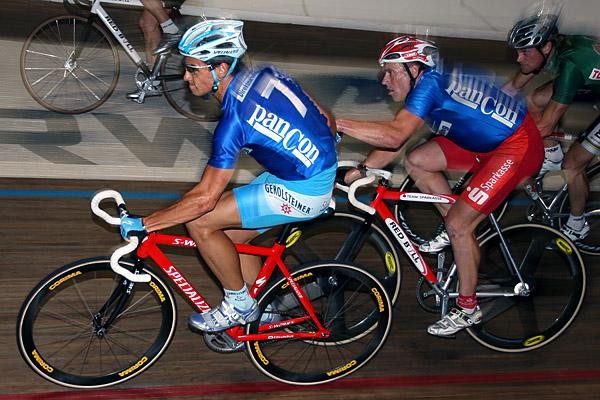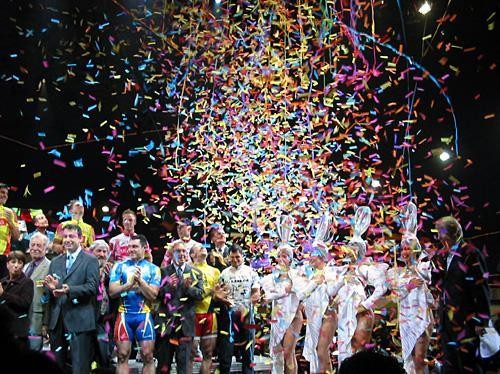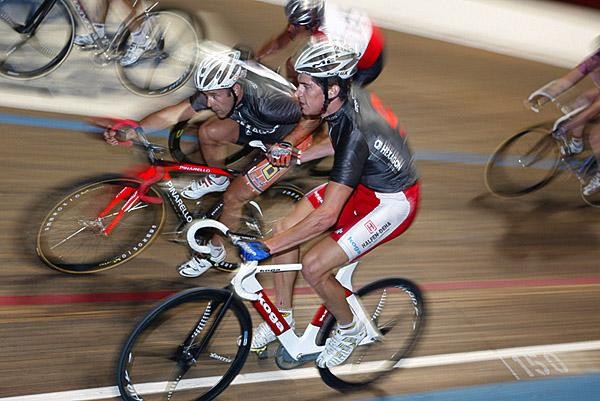New six-day season underway
Track feature, October 17, 2006 The winter season of indoor six-day track races is getting into full...



Track feature, October 17, 2006
The winter season of indoor six-day track races is getting into full swing, and promises to be one of the most exciting for many years. The six-day season runs from September through to February, and this year sees two new events on the calendar and a big shake-up amongst the top riders.
Six-day races are held on short indoor tracks across Europe. Racing takes place each evening, often finishing at two or three in the morning, and usually combines two Madison races each evening with various other points-scoring events such as flying laps, action-packed Derny racing behind pacing motorbikes, elimination races where the last rider across the line each lap is eliminated from the race, and points races.
The Madison races are where the crucial lap gains are made and lost, while the supporting races are where the teams fight to increase their points totals. Points are good, but lap gains are more important. You can have all the points in the world, but if another team gains a lap over you, they win the event. And of course, there is the atmosphere: whether a small track like Ghent in Belgium, where 4,000 beer-drinking fans cheer on their local heroes, or a big track like Munich with up to 12,000 spectators and an entire fun fair inside the hall, every six-day race is guaranteed to have a lively, exciting atmosphere.
Calendar
Over the last few years, a few of the 'classic' six-day races have disappeared. The Zurich Six in Switzerland, once famed for finishing at five in the morning, was last run in 2001. The Cologne Six in Germany was traditionally held over New Year's day, but the stadium was redeveloped in the late 1990’s and the race was lost from the calendar. Some spoke of a decline in six-day racing, but the fans remained faithful and recently, we have seen new six-day races appearing each year. The Amsterdam Six re-appeared on the calendar in 2000, now held in a shiny new velodrome. Another Dutch six-day classic, the Rotterdam Six, started up again in 2004 after a gap of several years. And last season, Belgium gained a second six-day race with the Hasselt Six, held in February 2006.
And this year, we have two new six-day races. Holland gains a third Zesdaagse, in Maastricht. It was held in September, and proved to be an exciting fight between three top teams that have all been newly formed this season. Every bit as exciting is the return of the Zurich Six in Switzerland. This gives the many Swiss six-day fans a race in their home country, and the good news for fans living further away is that the Zurich Six will be held over New Year's day, so it should attract a high number of European cycling fans eager to see in the New Year in style. The new Zurich Six is being organised by Swiss star Urs Freuler, himself a top six-day rider right up to the late 1990's.
Get The Leadout Newsletter
The latest race content, interviews, features, reviews and expert buying guides, direct to your inbox!
Riders
In a six-day race, the riders race in teams of two (or very occasionally in teams of three - the Stuttgart Six in Germany has introduced three-man teams in recent years, since this makes racing on the long Stuttgart track more exciting). Many riders have regular partners, and race as a regular pair in most events during the season.
This year, three of the top teams on the six-day circuit have had change thrust upon them. First Matthew Gilmore suffered serious injuries in a crash while riding a road race, and he is expected to be out of competition until January 2007. Gilmore rides on a Belgian licence (his dad Graeme was also a six-day rider. Matt was born in Belgium, and thus has Belgian nationality), and for the last couple of years he has been riding with Iljo Keisse, a very exciting young Belgian rider. They make a good team, and won their 'home' six-day race in Ghent in November 2005. With Gilmore out due to injury, Keisse is riding with experienced Italian six-day pro Marco Villa, who was for many years the regular partner of top star Silvio Martinello. Keisse is smart enough to learn as much as possible from Villa while riding with him - and quick enough for the two of them to win a six-day race. They picked up second place in the recent Maastricht Six.
Since Silvio Martinello retired a couple of years ago, the top dogs of six-day racing have been the Swiss "Alpine Express", Bruno Risi and Kurt Betschart. They have dominated six-day racing for over a decade, but all good things must come to an end: Kurt Betschart announced his retirement in July. Super-fast trackie Bruno Risi did not have to look far to find a suitable partner - two years ago he won the world Madison championships when paired with another top Swiss six-day man, Franco Marvulli. Risi and Marvulli are now aiming to ride as a regular pair on the six-day circuit, and they started out as they mean to go on by winning the new Maastricht Six in convincing style, and then winning the European Madison championships. Risi is 37 years old now, but word is that he has his eyes firmly fixed on a medal at the 2008 Beijing Olympics, so Risi will ride at least another two or three six-day seasons.
Finally, Dutch fastman Robert Slippens has ridden with Danny Stam for the last few years, the two of them always looking very stylish and very fast. Rob Slippens had a bad crash in August, and is also unlikely to race again before January 2007. This has meant Danny Stam has teamed up with Peter Schep, winner of the Points race in the 2006 world track championships. Again, this new pairing put in a superb performance in Maastricht, and they will be keen to win a six-day race this side of Christmas.
And of course, the absence of three of the 'toppers' means there is space for three new riders on the track. There are some very exciting new riders coming into the six-day races. Keep an eye open for new Danish six-day riders, for example.
The full six-day race calendar 2006-2007